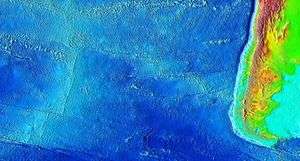Estratos de Pupunahue
| Estratos de Pupunahue Stratigraphic range: Eocene–Miocene | |
|---|---|
| Underlies | Santo Domingo Formation |
| Overlies | Bahía Mansa Metamorphic Complex |
| Lithology | |
| Primary | Conglomerate, Sandstone, mudstone |
| Other | Coal, volcanic ash |
| Location | |
| Region |
Los Ríos Region Los Lagos Region |
| Country | Chile |
| Type section | |
| Named for | Pupunahue |
| Named by | Henning Illies |
Estratos de Pupunahue is the name given to the sedimentary strata of Oligocene-Miocene age that crop out in Pupunahue and Mulpún near Valdivia, Chile. Outside this locality Estratos de Pupunahue extends below surface over a larger area. The thickness of the strata vary from a few meters to 530 meters. The strata were initially described by Henning Illies.[1] The strata are made up of conglomerate, sandstone and mudstone (Chilean Spanish: fangolita). The clast of the conglomerates are made up of metamorphic rock and the disposition of the conglomerates varies from clast-supported to matrix-supported. The sandstone and mudstone contains layers of lignite coal that do exceed 30 cm in thickness.[1]
The strata are made up of conglomerate, sandstone and mudstone (Chilean Spanish: fangolita). Coal layers found in the Estratos de Pupunahue have been exploited in Catamutún mine.[1]
